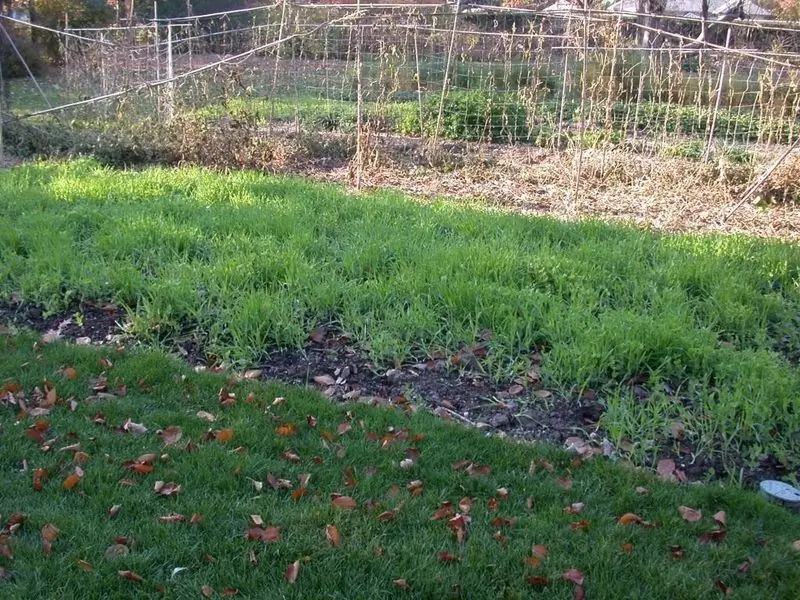
Table of contents:
- Author Bailey Albertson [email protected].
- Public 2023-12-17 12:53.
- Last modified 2025-01-23 12:41.
What green manure is better to sow in autumn: choosing the most useful

At the end of the season, when all the vegetables and herbs are removed, the garden looks dull: the beds are empty, bare, the wind blows fallen leaves on them. But if you sow siderates, everything will turn green! These crops will not only decorate the garden in autumn, but also cover the land from weeds, protect it from erosion and drying out, saturate the soil with useful substances and loosen it.
Content
- 1 What are siderates and why are they needed
-
2 What green manure is better to sow in autumn
- 2.1 Cereals
- 2.2 Legumes
- 2.3 Cruciferous
- 2.4 Mixtures
- 3 What to do with green manure before winter
- 4 Video: siderates from A to Z
What are siderates and why are they needed
Probably, there are no longer any gardeners left who have not heard about green manure. These are crops that are grown before or after the main planting, as well as on free "resting" soils. They are not allowed to bloom and grow seeds, and the green mass is embedded in a fertile soil layer.
Why do they do this work:
-
to improve the structure of the soil - the roots of green manure are powerful, they penetrate deep into the soil, they loosen dense soil well, and they keep too light (sandy) from crumbling;

Siderat roots Siderata have powerful roots that loosen the soil well
- to enrich the fertile layer with nitrogen - siderates from the legume family interact with nitrogen-fixing bacteria, which convert this element into a form more accessible to plants;
- to fertilize the soil - the roots of green manure help nutrients to get from deep soil layers to cultivated plants, and when rotted, they turn into compost;
- to protect against weeds - due to the rapid growth of dense foliage, green fertilizers create shade and simply do not leave empty space in the garden;
- for soil mulching - both green and green manure embedded in the soil retain moisture in the soil (in the fall - rain, in the spring - thawed), preventing the soil from drying out and eroding.
What green manure is better to sow in autumn
The most popular crops for autumn planting are cereals, cruciferous and legumes. They cover the ground with a carpet after harvesting cultivated plants, preventing weeds from growing. Green manures are sown when the air temperature allows the seeds to germinate and give greens before frost. Sowing usually begins at the end of summer (for example, after onions, winter garlic) and ends at the end of September - early October (depending on the weather in the region).
Cereals
The best grain siderates for planting in autumn are winter rye and oats.
Winter rye competes well with weeds, quickly gaining enough green mass to completely cover the land. Its deeply penetrating roots lift nutrients into the upper fertile layer and enrich the soil with silicon.
However, it is important to mow the plantings on time in the fall, otherwise it will be difficult to get rid of them in the spring: the rye will begin to grow and turn into a weed. The right moment for mowing is when the crop has finished tillering, but has not yet entered the stalking phase. You can find out exactly when such a moment will come by the yellowing and death of the lower leaves of the rye bush.

It is necessary to mow winter rye at the end of the tillering phase, while the plants are still young
Autumn is the most suitable time for sowing rye, since during the winter the green manure cut down to the root will rot and will not oppress the crops planted after it.
Oats do well on clay soils. It is often planted mixed with vetch. Oats enrich the soil with potassium, which is necessary for the successful wintering of plants, and vetch with nitrogen.

Oats work well when mixed with spring vetch
Legumes
Green fertilizers of the legume family are excellent for sowing in the fall on those beds where next year it is planned to grow potatoes, greens, cucumbers, tomatoes, cabbage and other crops with a great need for nitrogen, which legumes perfectly accumulate in the soil. This is due to the nodule bacteria that live in the roots of plants. They extract nitrogen from the air and convert it into an organic form available to horticultural crops.
An excellent autumn green manure is an annual lupine. It grows quickly and loosens the soil thanks to its deeply buried roots. The alkaloids contained in the plant allow you to drive out the wireworm from the beds. The most unpretentious variety that is not afraid of frost is narrow-leaved blue lupine.

Lupine blue, which is known to many as just a weed, can be grown as a siderat
Sowing peas, or pelushka, which also enriches the land with nitrogen, can be sown in late summer or autumn only in warm regions, in others it will not have time to grow to the required size.
Cruciferous
Oil radish is excellent for areas heavily weedy, as it is unpretentious, grows very quickly and gives a huge amount of greenery. And also she relieves the site of the nematode, subject to annual sowing.

Due to its rapid growth, oil radish is suitable for populating very neglected areas
White mustard, in addition to creating a carpet from weeds, heals the earth from late blight and nematodes, just like oil radish. For the development of spores of late blight fungi, the presence of iron in the soil is necessary. And this element takes mustard from the earth, depriving the pathogen of the conditions for activation. White mustard is especially useful in a greenhouse, where it is not possible to frequently change the soil or follow the rules of crop rotation. The wireworm does not like mustard either, and regular sowing will protect the plants from this pest.

White mustard is perhaps the most popular green manure in central Russia
In symbiosis with mustard roots, there are microorganisms that "pull out" phosphorus and potassium from compounds that are difficult to assimilate by cultivated plants.
But it is useless to sow buckwheat in the fall due to its low cold resistance. Siderat will freeze out in autumn frosts, not having time to build up the green mass.
All of the above-mentioned siderates of the cruciferous family have one significant drawback - although they fight some pests, they attract a cruciferous flea to the garden. In the spring, after these crops, you cannot plant radishes, turnips and cabbage. However, in autumn, this minus is insignificant, since insects are not active in cold weather. Therefore, mustard and oil radish are ideal autumn green manures.
Least of all fleas settle on rapeseed. This member of the family, thanks to its large leaves, perfectly covers the soil, giving no chance for weeds. In addition, rape does not allow nitrogen to be washed out of the soil, binding it. In the process of decaying rape greens, nitrogen is stored in humus for spring planting. Along with other members of the family, rapeseed enriches the fertile layer with potassium, calcium and sulfur.

In regions with a long, warm autumn, rapeseed has time to bloom
Mixes
In addition to the well-known vetch-oat mixture sold in any garden store, you can mix other green manures. For example, lupine, which protects plants from root rot and phytophthora, can be planted together with mustard, oil radish, rapeseed after tomatoes so that the plants do not get sick the next year.
And in general, any siderates can be mixed, planted in bulk or like an alpine lawn. It is advisable to change green fertilizers on the site, since each has its own beneficial properties, and it will be good if all this usefulness manifests itself in the beds.

Different siderates can be mixed when planting
What to do with green manure before winter
It all depends on the time of planting. Siderata planted in late summer - early autumn, which managed to bloom or go into the stalking phase, must be mowed or chopped down at the root, that is, slightly below ground level. Crops sown in the second half of September can simply be left in the garden. They will no longer bloom, and after frost they will simply lie on the ground. There is no need to dig up green manure and dig up the soil - this will prevent the roots from doing their job. Indeed, even after mowing the tops, the roots loosen and structure the soil.

There is no need to dig a garden bed with siderates, it is enough just to cut the plants with a shovel or flat cutter
Video: siderates from A to Z
The earth, like nature in general, does not tolerate emptiness. So that the beds do not remain bare after harvesting, it is worth sowing siderates in the fall. It is important to select the plants that will provide the most benefits in a specific soil type for specific plants.
Recommended:
Which Epilator Is Better For Home Use - Laser And Other Types, For The Face And Bikini Area, Options For Sensitive Skin, Basic Parameters And User Reviews

Appointment and types of epilators. Description of the action of the devices. How to choose the best among them. What are the rules for caring for him. Reviews of the best brands
How To Choose An Electric Shaver For Men: Which Is Better, A Review Of Models And Reviews

What you need to consider in order to choose the right electric shaver. Review of popular models and user reviews
"Whiskas" Food For Adult Cats And Kittens: Review, Composition, Range, Pros And Cons, Reviews Of Veterinarians And Owners, Comparison With "Friskas"

What the Whiskas food contains. Can I give it to animals. Is it worth changing the feed "Whiskas" to "Friskis"
Phacelia Siderata: When To Sow In Spring, Remove And Bury, Reviews

Why sow phacelia, what does it give, after what crops can you do it. Instructions for sowing and application in spring, summer, autumn. Reviews about the cultivation. Video
How To Choose A Good Electric Toothbrush For An Adult And A Child And Which Manufacturers Are Better + Videos And Reviews

How to choose an electric toothbrush? Rating of brushes from different manufacturers for adults and children, expert advice and customer reviews
